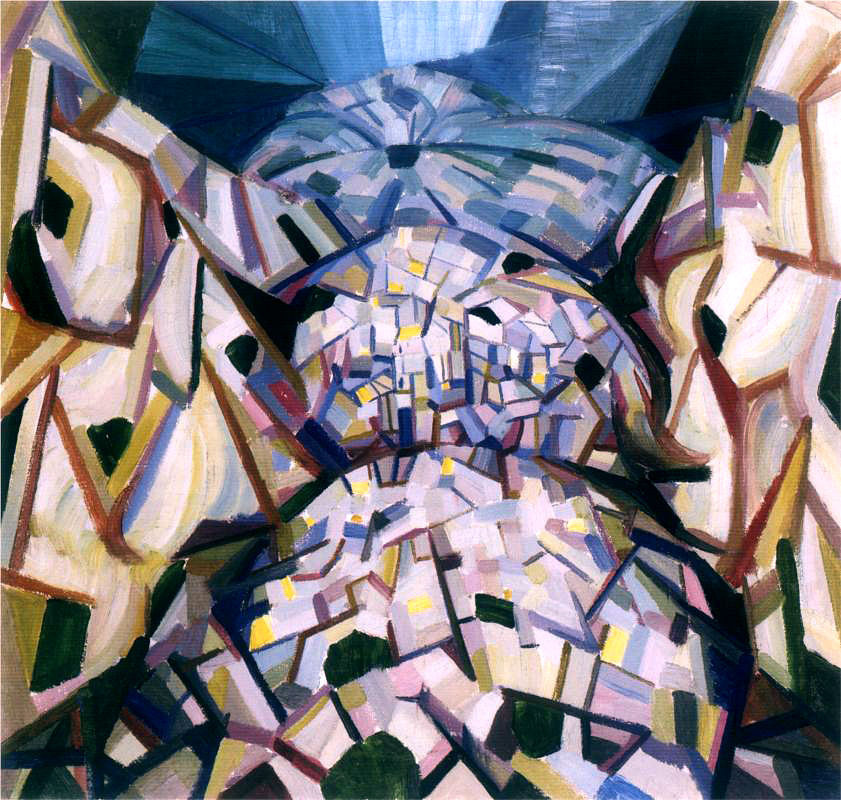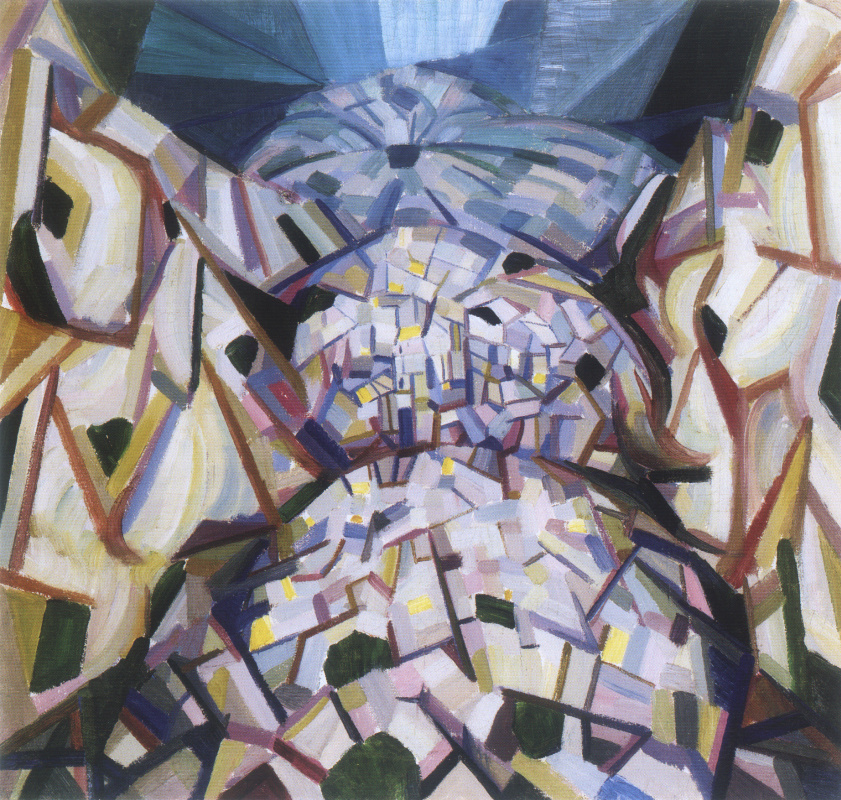log in
Enter site
Login to use Arthive functionality to the maximum
Abstract landscape (Nagorno-Karabakh)
Alexander Konstantinovich Bogomazov • Painting, 1915, 60×64 cm
Description of the artwork «Abstract landscape (Nagorno-Karabakh)»
Picture "Abstract landscape" written by the artist Bogomazov in 1915 during his stay in Nagorno-Karabakh. There he taught for two years in the village of Gerusy (now Goris). The canvas broke the record at Sotheby's in 2005. Having received a preliminary assessment of the cost of 220 - 280 thousand pounds, in the end it was sold for an amount three times higher than the estimate: 736 thousand British pounds!
As this, unfortunately, often happens, the author of the painting vegetated in poverty and was forced to write humiliating letters to the Soviet government in order to receive payment for his labor and livelihood. Yes, and Bogomazov died at the age of only 50 years from tuberculosis - a disease that in 1930 was already treatable, subject to normal nutrition and adequate treatment.
Perhaps there was some plus in the fact that he did not live to see the moment when in 37 the authorities began to create a “special fund”, where paintings from all over Ukraine were collected that were to be destroyed as dubious or contrary to Soviet ideology. When it came directly to the denouement, in 1952 about 2,000 paintings were burned in Lviv. Something went wrong in Kiev, and paintings miraculously survived.
The canvases were wound on a shaft and stored in such a barbaric way until the Central Committee expressed a desire to see the work of some executed artists. Workers of the National Art Museum of Ukraine were instructed to remove the works from the rampart, and as a result, paintings by Bogomazov were found in the back room of the museum, Palmovaand other avant-garde artists.
The main curator of the museum at that time was art critic Dmitry Gorbachev. He became interested in the finds, did not wrap them back in rolls, but, on the contrary, began restoration and attribution: “It turned out that one work to be written off belonged to Alexandre Exter- he recalls. - If now this picture was sold at the Sotheby's auction, it would cost 2 - 3 million dollars! And there she was both ownerless and nameless. But on it I saw some numbers. I looked in the inventory of the 30s - it says “External”. Some uneducated museum worker wrote - after all, all literate people were shot. Then I determined authorship Lisitsky, now a classic of world art, who here in Kiev, worked under the influence of Exter.
Gorbachev began bit by bit to collect information about the artists he found. He met with the widow of Bogomazov Wanda Monastyrskaya, and in 1966 held a semi-legal exhibition of the cubo-futurist in the Union of Writers of Ukraine.
It got ridiculous. The art critic recalls how a married couple Marcade, who is interested in Ukrainian avant-garde painting, came to visit the museum from France. The director of the museum could not give permission to show the paintings to foreigners without coordination with higher authorities (and would hardly have received a positive answer from them). But he found a witty way out of the situation: “Let them sit in the corridor, and you pretend that you are transferring paintings from one store to another”.
It is not known in what ways the canvas of Bogomazov's "Abstract Landscape" got abroad. Who knows, maybe some lovers of the Soviet avant-garde like Marcade’s married couple managed to take him out. It is only known that if the main curator of the art museum in Bogomazov’s homeland was nevertheless fired for his increased interest in gifted Ukrainian artists, the painting “Abstract Landscape” was shown in London: in 1973 at the exhibition “The Art of Russian Suprematists and Constructivists” and four years later - in the exposition “The World of the Pointless”. Verily, there is no prophet in his own country.
The author: Natalia Azarenko
Masterpieces in rolls
As this, unfortunately, often happens, the author of the painting vegetated in poverty and was forced to write humiliating letters to the Soviet government in order to receive payment for his labor and livelihood. Yes, and Bogomazov died at the age of only 50 years from tuberculosis - a disease that in 1930 was already treatable, subject to normal nutrition and adequate treatment.
Perhaps there was some plus in the fact that he did not live to see the moment when in 37 the authorities began to create a “special fund”, where paintings from all over Ukraine were collected that were to be destroyed as dubious or contrary to Soviet ideology. When it came directly to the denouement, in 1952 about 2,000 paintings were burned in Lviv. Something went wrong in Kiev, and paintings miraculously survived.
The canvases were wound on a shaft and stored in such a barbaric way until the Central Committee expressed a desire to see the work of some executed artists. Workers of the National Art Museum of Ukraine were instructed to remove the works from the rampart, and as a result, paintings by Bogomazov were found in the back room of the museum, Palmovaand other avant-garde artists.
The main curator of the museum at that time was art critic Dmitry Gorbachev. He became interested in the finds, did not wrap them back in rolls, but, on the contrary, began restoration and attribution: “It turned out that one work to be written off belonged to Alexandre Exter- he recalls. - If now this picture was sold at the Sotheby's auction, it would cost 2 - 3 million dollars! And there she was both ownerless and nameless. But on it I saw some numbers. I looked in the inventory of the 30s - it says “External”. Some uneducated museum worker wrote - after all, all literate people were shot. Then I determined authorship Lisitsky, now a classic of world art, who here in Kiev, worked under the influence of Exter.
Art from the floor
Gorbachev began bit by bit to collect information about the artists he found. He met with the widow of Bogomazov Wanda Monastyrskaya, and in 1966 held a semi-legal exhibition of the cubo-futurist in the Union of Writers of Ukraine.
It got ridiculous. The art critic recalls how a married couple Marcade, who is interested in Ukrainian avant-garde painting, came to visit the museum from France. The director of the museum could not give permission to show the paintings to foreigners without coordination with higher authorities (and would hardly have received a positive answer from them). But he found a witty way out of the situation: “Let them sit in the corridor, and you pretend that you are transferring paintings from one store to another”.
It is not known in what ways the canvas of Bogomazov's "Abstract Landscape" got abroad. Who knows, maybe some lovers of the Soviet avant-garde like Marcade’s married couple managed to take him out. It is only known that if the main curator of the art museum in Bogomazov’s homeland was nevertheless fired for his increased interest in gifted Ukrainian artists, the painting “Abstract Landscape” was shown in London: in 1973 at the exhibition “The Art of Russian Suprematists and Constructivists” and four years later - in the exposition “The World of the Pointless”. Verily, there is no prophet in his own country.
The author: Natalia Azarenko



